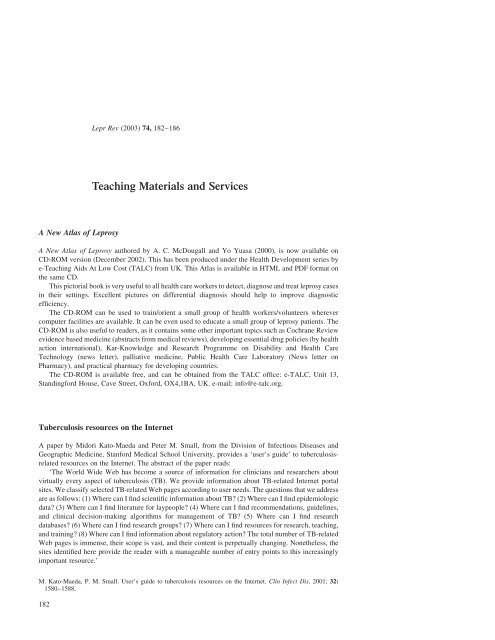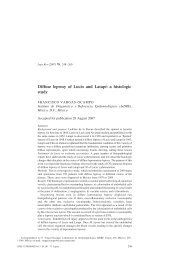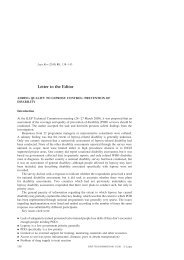182 A New Atlas of Leprosy * Tuberculosis resources
182 A New Atlas of Leprosy * Tuberculosis resources
182 A New Atlas of Leprosy * Tuberculosis resources
You also want an ePaper? Increase the reach of your titles
YUMPU automatically turns print PDFs into web optimized ePapers that Google loves.
A <strong>New</strong> <strong>Atlas</strong> <strong>of</strong> <strong>Leprosy</strong><br />
Lepr Rev �2003) 74, <strong>182</strong>±186<br />
Teaching Materials and Services<br />
A <strong>New</strong> <strong>Atlas</strong> <strong>of</strong> <strong>Leprosy</strong> authored by A. C. McDougall and Yo Yuasa �2000), is now available on<br />
CD-ROM version �December 2002). This has been produced under the Health Development series by<br />
e-Teaching Aids At Low Cost �TALC) from UK. This <strong>Atlas</strong> is available in HTML and PDF format on<br />
the same CD.<br />
This pictorial book is very useful to all health care workers to detect, diagnose and treat leprosy cases<br />
in their settings. Excellent pictures on differential diagnosis should help to improve diagnostic<br />
ef®ciency.<br />
The CD-ROM can be used to train/orient a small group <strong>of</strong> health workers/volunteers wherever<br />
computer facilities are available. It can be even used to educate a small group <strong>of</strong> leprosy patients. The<br />
CD-ROM is also useful to readers, as it contains some other important topics such as Cochrane Review<br />
evidence based medicine �abstracts from medical reviews), developing essential drug policies �by health<br />
action international), Kar-Knowledge and Research Programme on Disability and Health Care<br />
Technology �news letter), palliative medicine, Public Health Care Laboratory �<strong>New</strong>s letter on<br />
Pharmacy), and practical pharmacy for developing countries.<br />
The CD-ROM is available free, and can be obtained from the TALC <strong>of</strong>®ce: e-TALC, Unit 13,<br />
Standingford House, Cave Street, Oxford, OX4,1BA, UK. e-mail: info@e-talc.org.<br />
<strong>Tuberculosis</strong> <strong>resources</strong> on the Internet<br />
A paper by Midori Kato-Maeda and Peter M. Small, from the Division <strong>of</strong> Infectious Diseases and<br />
Geographic Medicine, Stanford Medical School University, provides a `user's guide' to tuberculosisrelated<br />
<strong>resources</strong> on the Internet. The abstract <strong>of</strong> the paper reads:<br />
`The World Wide Web has become a source <strong>of</strong> information for clinicians and researchers about<br />
virtually every aspect <strong>of</strong> tuberculosis �TB). We provide information about TB-related Internet portal<br />
sites. We classify selected TB-related Web pages according to user needs. The questions that we address<br />
are as follows: �1) Where can I ®nd scienti®c information about TB? �2) Where can I ®nd epidemiologic<br />
data? �3) Where can I ®nd literature for laypeople? �4) Where can I ®nd recommendations, guidelines,<br />
and clinical decision-making algorithms for management <strong>of</strong> TB? �5) Where can I ®nd research<br />
databases? �6) Where can I ®nd research groups? �7) Where can I ®nd <strong>resources</strong> for research, teaching,<br />
and training? �8) Where can I ®nd information about regulatory action? The total number <strong>of</strong> TB-related<br />
Web pages is immense, their scope is vast, and their content is perpetually changing. Nonetheless, the<br />
sites identi®ed here provide the reader with a manageable number <strong>of</strong> entry points to this increasingly<br />
important resource.'<br />
M. Kato-Maeda, P. M. Small. User's guide to tuberculosis <strong>resources</strong> on the Internet. Clin Infect Dis, 2001; 32:<br />
1580±1588.<br />
<strong>182</strong>
TB vaccines for the world<br />
The First International Conference on `TB Vaccines for the World �TBV 2003) will be held on 17±19<br />
September 2003, in Montreal, Canada. One in every three people on earth is believed to be infected with<br />
Mycobacterium tuberculosis, leading to 7±8 million cases <strong>of</strong> active tuberculosis �TB) per year and<br />
approximately 3 million deaths annually. This epidemic, like those <strong>of</strong> most infectious diseases, creates<br />
scienti®c challenges and opportunities as it raises the demand for public health solutions. The currently<br />
available weapons for ®ghting TB are inadequate. The ultimate goal <strong>of</strong> biomedical TB research is to<br />
lessen the public health burden <strong>of</strong> this disease by developing improved diagnostic, therapeutic, and<br />
intervention strategies. Achieving this goal requires a base <strong>of</strong> knowledge about the biology <strong>of</strong> M.<br />
tuberculosis and related mycobacteria, their interactions with human and animal hosts, and the nature <strong>of</strong><br />
an effective host-protective immune response. TB researchers are applying this accumulating base <strong>of</strong><br />
knowledge to developing rapid, easy-to-use diagnostic assays appropriate for low-as well as highincome<br />
countries, improving the current complicated therapeutic regimen, identifying potential new<br />
drugs to combat multidrug-resistant TB, and creating more effective vaccines �Ann M. Ginsberg,<br />
NIAID/NIH, Bethesda, USA).<br />
TBV 2003 will focus attention on `Vaccine Issues' in relation to TB worldwide. TB vaccines is a<br />
developing area <strong>of</strong> activity and TBV 2003 will allow researchers to come together to discuss the latest<br />
®ndings and trends associated with the research and development <strong>of</strong> TB vaccines.<br />
Training in information management <strong>of</strong> web-based <strong>resources</strong><br />
Teaching Materials and Services 183<br />
The following article appears in TDR <strong>New</strong>s, volume 69, November 2002.<br />
An international training course on electronic information management <strong>of</strong> web-based <strong>resources</strong> was<br />
held in Tanzania, July 2002, under the auspices <strong>of</strong> HINARI, the Health Internetwork Access to<br />
Research Initiative. HINARI, a public-private initiative aiming to bridge the digital divide in health,<br />
was launched in 2000 by the United Nations Secretary General. Spearheaded by WHO, the Health<br />
InterNetwork brings together international agencies, the private sector, foundations, non-governmental<br />
organizations and country partners under the principle <strong>of</strong> ensuring equitable access to health<br />
information. Its focus is on improving the information environment <strong>of</strong> health personnel in developing<br />
countries: pr<strong>of</strong>essionals, researchers, scientists, policy-makers. The core elements <strong>of</strong> the project are<br />
content, Internet connectivity, and capacity building.<br />
HINARI will enable over 100 countries to bene®t from access to global health research. During its<br />
®rst year, the Initiative achieved a major breakthrough when the world's major biomedical publishers<br />
agreed to provide access to more than 2000 scienti®c publications for free or at low cost to universities,<br />
medical schools, research institutions and government <strong>of</strong>®ces in low-income countries.<br />
As part <strong>of</strong> its commitment to capacity building, TDR assists HINARI by providing infrastructure<br />
support to selected institutes and organizing training programmes in how to access, organize and<br />
manage the wealth <strong>of</strong> material available on the Internet. Eleven librarians and information managers<br />
from seven countries �Cameroon, Ethiopia, Ghana, Kenya, Nigeria, Tanzania, Uganda) participated in<br />
the workshop in Tanzania on information management <strong>of</strong> HINARI and other web-based <strong>resources</strong>. The<br />
majority <strong>of</strong> the participants came from centres forming part <strong>of</strong> the MIMCom network.<br />
Presentations and hands-on sessions at the workshop covered general computer skills, overview <strong>of</strong><br />
the Internet, an introduction to the HINARI menu, and how to search publishers' sites �HINARI menu<br />
option). Participants learned to search PubMed and identify and access free information <strong>resources</strong> on the<br />
Internet. They learned how to evaluate the quality <strong>of</strong> information on the Internet, and how to organize<br />
electronic collections including use <strong>of</strong> EndNote # reference manager s<strong>of</strong>tware for citation import and<br />
management.<br />
Participants also contributed to the evaluation and development <strong>of</strong> teaching materials. After<br />
re®nement at a further workshop to be held in the ®rst quarter <strong>of</strong> 2003 hosted by the WHO regional
184<br />
<strong>of</strong>®ce for South East Asia, <strong>New</strong> Delhi, for selected participants from WPRO and SEARO, these<br />
materials will constitute a teaching package to be available from TDR in late 2003.<br />
The workshop clearly demonstrated that access to information is possible in developing countries,<br />
despite the fact that high-speed Internet access and a LAN are advised. Internet access at the National<br />
Institute <strong>of</strong> Medical Research in Dar es Salaam, while not perfect, allowed all participants to learn and<br />
gain experience in real time.<br />
HINARI is expected to have implications that extend beyond access to information. It is envisioned<br />
that better and timely information will increase the capacity <strong>of</strong> scientists and health care workers in<br />
developing countries to participate in the global research agenda; to better set national research and<br />
health care priorities; and to increase their countries' self-reliance in developing evidenced-based<br />
strategies and tools for the prevention, control and treatment <strong>of</strong> disease.<br />
The international training course on electronic information management <strong>of</strong> HINARI and other<br />
web-based <strong>resources</strong> was hosted by the National Institute for Medical Research, Dar es Salaam,<br />
Tanzania.<br />
<strong>New</strong> TALC catalogue<br />
The new TALC catalogue for 2003 is now available. TALC is now accepting books from many<br />
publishers, and the list contains many new items, including CD-ROMs and slide collections. Further<br />
information can be obtained from the TALC website, www.talcuk.org, or by e-mail �info@talcuk.org).<br />
e-TALC<br />
Teaching Materials and Services<br />
The following article appears on TALC's website �www.talcuk.org).<br />
To support TALC's continuing work in providing low cost health information TALC has initiated a<br />
pioneering project to provide free information to health workers in the developing countries on<br />
CD-ROM. Although availability <strong>of</strong> computers is still limited in the developing countries it is growing<br />
fast, while access to the Internet is still very poor, due to cost and poor telephone systems.<br />
CD-ROMs can store large quantities <strong>of</strong> high quality information. They can be produced and<br />
distributed at low cost.<br />
This service is designed to achieve the following:<br />
· Production <strong>of</strong> CD-ROMs with search engines, containing copyright free information. The<br />
CD-ROMs are easy to use and have the potential to be interactive �e.g. for training purposes).<br />
· The CD-ROMs will provide free access to up-to-date and appropriate health and development<br />
information and training materials for health workers.<br />
· A low cost method for health workers, libraries, government and non-governmental organizations to<br />
distribute health information and training <strong>resources</strong>.<br />
· A vehicle for the exchange <strong>of</strong> ideas.<br />
The CD-ROMs will allow users to select, adapt and tailor materials to meet local needs and develop<br />
their own Library <strong>of</strong> materials at very low cost. Information on the CD-ROM can be downloaded,<br />
e-mailed or printed and freely reproduced and shared. The project has already met with a great deal <strong>of</strong><br />
interest, and TALC is developing partnerships with a number <strong>of</strong> major organizations that wish to use the<br />
service.<br />
TALC would also like to hear from organizations from developing countries that have appropriate<br />
material that would bene®t from wider circulation via the e-TALC CD-ROM.<br />
If you would like more information or would like to receive a copy <strong>of</strong> the CD-ROM or are interested<br />
in putting material on it please contact: e-TALC, c/o PO Box 49, St Albans, Herts AL1 5TX, UK.<br />
e-mail: e-talc@talcuk.org; website: www.e-talc.org.
Communicable diseases information <strong>resources</strong>Ðtuberculosis<br />
The World Health Organization has published an impressive list <strong>of</strong> signi®cant publications on<br />
tuberculosis �Communicable diseases information <strong>resources</strong>, no. 7, January2001±December 2002).<br />
Items added since the previous catalogue include:<br />
· DOTS-Plus: preliminaryresults and emerging issues. Proceedings <strong>of</strong> the meeting <strong>of</strong> the Stop TB<br />
working group on DOTS-Plus for MDR-TB, Tallinn, Estonia, 10±12 April 2002. English.<br />
WHO/CDS/TB/2002.307.<br />
· Communitycontribution to TB care: a Latin American perspective. English. WHO/CDS/TB/<br />
2002.04.<br />
· Communitycontribution to TB care: an Asian perspective. English. WHO/CDS/TB/2002.302.<br />
· A guide for tuberculosis treatment supporters. English. WHO/CDS/TB/2002.300.<br />
The catalogue can be obtained from CDS Information Resource Centre, World Health Organization,<br />
1211 Geneva 27, Switzerland. Fax: +41 22 791 42 85; e-mail: cdsdoc@who.int. It is also available<br />
on-line as a downloadable PDF ®le at http://who.int/infectious-disease-news.<br />
Topics in International Health CD-ROM<br />
Teaching Materials and Services 185<br />
The Topics in International Health series has been developed bythe Wellcome Trust for use as an<br />
interactive educational resource in tropical and international health. The series is designed for use by<br />
medical and life science students, researchers, and healthcare pr<strong>of</strong>essionals.<br />
All the information on the CD-ROMs has been reviewed byexperts to ensure that it is<br />
comprehensive, accurate, and up to date. The topics are presented in a clear and simple format to<br />
help explain complex concepts.<br />
Three complementary<strong>resources</strong> are contained on each <strong>of</strong> these unique CD-ROMs: a selection <strong>of</strong><br />
interactive tutorials, an image collection and a glossary. Each part in the series focuses on a disease or<br />
group <strong>of</strong> diseases <strong>of</strong> worldwide importance.<br />
Tutorials are highlyvisual, structured learning tools. The tutorials include objectives, selfassessment<br />
tests, a list <strong>of</strong> keyreferences to encourage further reading, and summaryscreens to reinforce<br />
the crucial points. Keyareas covered include:<br />
· The latest epidemiological data on leprosyfrom the World Health Organization �WHO).<br />
· Current WHO treatment regimens for multidrug therapy.<br />
· Comprehensive information on the WHO and Ridley±Jopling systems <strong>of</strong> classi®cation.<br />
· Detailed and fullyillustrated guides to the histopathological and clinical aspects <strong>of</strong> the<br />
Ridley±Jopling classi®cation.<br />
· A comprehensive guide to all aspects <strong>of</strong> ocular leprosyÐdiagnosis, treatment and prevention <strong>of</strong><br />
blindness.<br />
· How to treat and prevent physical impairment in leprosy.<br />
· When, whyand how to take skin biopsies and slit-skin smears.<br />
· Prevention and control <strong>of</strong> leprosyto WHO elimination levels.<br />
The Image Collection comprises approximately1000 images, carefullyselected to complement the<br />
tutorials. Each image is accompanied bya detailed description, searchable keywords, and disease and<br />
aetiological agent classi®cations.<br />
The Glossary de®nes the medical and scienti®c terms used in the tutorials and image descriptions. It<br />
has an easy-to-use interface, and will help users who are unfamiliar with medical terminology or whose<br />
®rst language is not English.<br />
For orders and enquiries, please contact: CAB International, Wallingford, Oxon OX10 8DE, UK.<br />
Tel: +44 1491 832111; Fax: +44 1491 829292; e-mail: publishing@cabi.org. Customers in North
186<br />
Teaching Materials and Services<br />
American should contact: CAB International, 10 East 40th Street, Suite 3203, <strong>New</strong> York, NY 10016,<br />
USA. Tel: +1 212 481 7018; Toll free: +1 800 528 4841; Fax: +1 212 686 7993; e-mail: cabi-nao@<br />
cabi.org.<br />
Local health content in Nigeria<br />
The following article appeared in Information Development, vol. 18, no. 3, September 2002 �source:<br />
http://www.iconnect-online.org/).<br />
A study funded by the UK Department for International Development �DfID) helps communities in<br />
Nigeria to use ICTs to document traditional healthcare knowledge. The Fantsuam Foundation, whose<br />
members are women's groups in rural communities in Kaduna State, has worked with rural women to<br />
try to understand various traditional healthcare practices and, where appropriate, to introduce `best<br />
practice' and safer techniques. The project recognizes the role <strong>of</strong> traditional medicine, especially in<br />
communities where it is the only healthcare available. These communities have a largely oral tradition<br />
with very little information in written form. This project is the ®rst attempt to document their traditional<br />
health knowledge and skills. Such knowledge remains the property <strong>of</strong> the communities.<br />
In addition to the knowledge and information collected from the population, other sources <strong>of</strong> health<br />
information are regularly consulted for information that can be adapted and grafted into the existing<br />
body <strong>of</strong> local knowledge and practices. The health channel <strong>of</strong> the WorldSpace Radio, Satelife, WHO<br />
fact sheets, and numerous discussion lists are translated into the local dialect and shared with the<br />
women.<br />
Information sharing is not a problem commonly encountered among the ordinary villagers. It is the<br />
traditional healers who feel threatened by dissemination <strong>of</strong> their knowledge and skills.<br />
Some lessons from the project:<br />
· Start with the knowledge base available within the community and build from there.<br />
· Developing local content cannot stand aloneÐit should be conducted within the context <strong>of</strong> a wider<br />
community health programme to facilitate its sustainability.<br />
· It is possible to evolve an information management system that preserves traditional knowledge and<br />
practices while making it receptive to new ideas about healthcare.<br />
· Traditional medical knowledge has aspects that can be modi®ed and improved for better healthcare<br />
delivery.<br />
· Local content that is largely determined by the host community has a better chance <strong>of</strong> being adapted,<br />
upgraded and improved through additional external information from orthodox medicine.<br />
· Traditional knowledge is amenable to modernization if the effort is one <strong>of</strong> partnership. Intellectual<br />
property rights can be safeguarded while making the knowledge available to all members <strong>of</strong> the host<br />
community.<br />
· It is important to have access to regular updates <strong>of</strong> reliable health information from a variety <strong>of</strong><br />
sources.<br />
· There is a need for local capacity for the translation <strong>of</strong> externally generated information from<br />
sources such as textbooks, newspapers, journals and the Internet into the local dialect.




